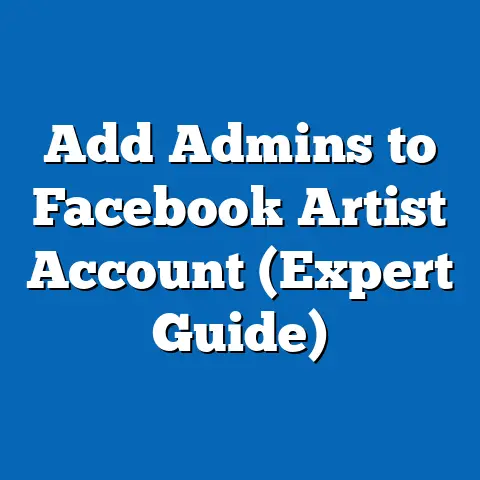Boost Band Visibility with Facebook Ads (Proven Strategies)
Boost Band Visibility with Facebook Ads: Proven Strategies
Imagine this: a sunny Saturday afternoon, a bustling outdoor festival, and a band pouring their hearts out on stage. They’re talented, their music is infectious, but the crowd is…well, underwhelming. It’s a story I’ve witnessed countless times. The talent is there, the passion is there, but the visibility is missing. In today’s digital age, getting your music heard requires more than just killer riffs and catchy lyrics. You need a solid marketing strategy, and that’s where Facebook Ads come in. Think of Facebook Ads as your digital megaphone, amplifying your music to the ears of potential fans who are just waiting to discover their new favorite band – you! This guide is your roadmap to mastering Facebook Ads and transforming your band’s online presence.
Understanding Facebook Ads
Facebook Ads aren’t just about throwing money at a platform and hoping for the best. They’re a sophisticated system that, when understood and leveraged correctly, can deliver incredible results for musicians and bands. Think of it as a targeted missile, aimed directly at the people most likely to dig your sound.
Facebook Ads: A Musician’s Best Friend
For bands, Facebook Ads offer several key advantages:
- Hyper-Targeting: Facebook’s data is unparalleled. You can target users based on their age, location, interests (think specific genres, favorite bands, etc.), and even their behavior (like attending concerts or engaging with music-related pages).
- Measurable Results: Unlike traditional advertising, you can track every dollar spent and see exactly how it’s contributing to your goals, whether it’s increasing website traffic, growing your fan base, or selling tickets to your next show.
- Budget Flexibility: You don’t need a record label budget to get started. You can run campaigns with as little as $5 a day and scale up as you see fit.
- Direct Fan Engagement: Facebook Ads can drive users directly to your music, your website, or your social media pages, fostering a direct connection with potential fans.
I remember working with a local indie band who were struggling to get their music heard outside of their hometown. They had a great sound, but their marketing efforts were limited to posting on social media and playing local gigs. We launched a Facebook Ads campaign targeting fans of similar indie bands in nearby cities. Within a few weeks, they saw a significant increase in website traffic, social media followers, and even ticket sales for their upcoming shows. It was a game-changer for them.
How Facebook’s Algorithm Works (In a Nutshell)
The Facebook algorithm, often referred to as the “News Feed Algorithm,” is a complex system that determines which content users see in their news feeds and in what order. It’s constantly evolving, but here are the core principles that matter to advertisers:
- Relevance: Facebook prioritizes content that it believes is most relevant to each individual user based on their past behavior, interests, and connections.
- Engagement: Content that generates high levels of engagement (likes, comments, shares, clicks) is more likely to be shown to a wider audience.
- Relationships: Content from friends and family is generally prioritized over content from businesses or brands.
- Timeliness: Newer content is generally given more weight than older content.
What this means for your ads: You need to create ads that are highly relevant to your target audience and that encourage engagement. This means crafting compelling ad copy, using high-quality visuals, and targeting the right people.
Different Types of Facebook Ads for Bands
Facebook offers a variety of ad formats, each with its own strengths and weaknesses. Here are a few that are particularly effective for bands:
- Image Ads: Simple but powerful. Use a high-quality photo of your band that captures your vibe and style. These are great for brand awareness and driving traffic to your website.
- Video Ads: Perfect for showcasing your music. Short, engaging music videos or live performance clips can capture attention and generate excitement.
- Carousel Ads: Allow you to showcase multiple images or videos in a single ad. This is great for highlighting different aspects of your band, such as your members, your music, and your upcoming events.
- Lead Generation Ads: Collect leads directly from Facebook without sending users to a landing page. This is useful for building your email list and promoting exclusive content or offers.
- Event Ads: Promote your upcoming shows and concerts. These ads can drive ticket sales and increase attendance.
Data and Statistics:
- According to Facebook, video ads are 5x more engaging than image ads.
- Carousel ads can generate 10x more traffic to your website than static image ads.
- Facebook users spend an average of 34 minutes per day on the platform, providing ample opportunity to reach potential fans.
Takeaway: Understanding the power of Facebook Ads and how the algorithm works is crucial for success. Experiment with different ad formats and targeting options to find what works best for your band.
Crafting Compelling Ad Content
Okay, you’ve got the basics down. Now, let’s talk about the heart of your Facebook Ads: the content. This is where you grab attention, spark interest, and convert potential fans into loyal followers. It’s about more than just slapping a picture on a post; it’s about crafting a narrative that resonates with your target audience.
The Essentials of Engaging Ad Content
Think of your ad as a mini-music video for your band. It needs to be visually appealing, emotionally engaging, and clearly communicate your message. Here are some key elements to consider:
- Headline: This is the first thing people see, so make it count. Use strong, attention-grabbing language that speaks to your target audience.
- Body Copy: Tell your story. Highlight your unique sound, your upcoming events, or your latest release. Keep it concise and engaging.
- Visuals: Choose high-quality photos or videos that capture your band’s vibe and style.
- Call to Action (CTA): Tell people what you want them to do. “Listen Now,” “Buy Tickets,” “Follow Us” – make it clear and easy for them to take the next step.
Writing Compelling Ad Copy
Your ad copy is your chance to connect with potential fans on a personal level. Here are some tips for writing copy that converts:
- Know Your Audience: Speak their language. Use slang, humor, or references that resonate with their interests.
- Highlight Your Unique Selling Proposition (USP): What makes your band different? What sets you apart from the competition?
- Create a Sense of Urgency: Use phrases like “Limited Time Offer” or “Tickets Selling Fast” to encourage immediate action.
- Tell a Story: People connect with stories. Share a brief anecdote about your band’s journey or the inspiration behind your latest song.
I once helped a folk band craft an ad campaign around their new album, which was inspired by their travels through the Appalachian Mountains. We used stunning photos of the mountains in the ads and wrote copy that highlighted the album’s themes of nature, adventure, and community. The campaign resonated deeply with their target audience, and they saw a significant increase in album sales and social media followers.
The Power of High-Quality Visuals
In the world of Facebook Ads, visuals are king. People are scrolling through their feeds at lightning speed, so you need to grab their attention instantly. Here are some tips for choosing the right visuals:
- Use High-Resolution Images: Blurry or pixelated images will turn people off.
- Choose Images That Capture Your Band’s Vibe: Your visuals should be consistent with your band’s overall brand and style.
- Consider Using Video: Video ads are incredibly engaging and can be used to showcase your music, your live performances, or your band’s personality.
- Test Different Visuals: Experiment with different images and videos to see what resonates best with your target audience.
Examples of Successful Ad Campaigns
Let’s take a look at some examples of successful ad campaigns from well-known bands and emerging artists:
- Example 1: The Killers – Utilized Facebook Ads to promote their new album by showcasing snippets of their music videos and behind-the-scenes footage. The ads targeted fans of alternative rock and indie music.
- Example 2: Billie Eilish – Used Facebook Ads to drive ticket sales for her tour by targeting fans who had previously engaged with her music on Spotify or Apple Music.
- Example 3: Local Indie Band “The Sunsets” – Ran a Facebook Ads campaign promoting their upcoming show at a local venue. The ads featured a high-quality photo of the band performing live and targeted fans of similar indie bands in the area.
Takeaway: Crafting compelling ad content is essential for success. Focus on writing engaging copy, using high-quality visuals, and telling your band’s story.
Targeting Your Audience
Okay, you’ve got killer content. Now, let’s make sure it reaches the right ears. Targeting is where Facebook Ads truly shine. You’re not just broadcasting to the world; you’re laser-focusing on the people most likely to become fans.
Why Audience Targeting Matters
Imagine trying to sell snowboards to people who live in Hawaii. It’s not going to work, right? The same principle applies to Facebook Ads. If you’re targeting the wrong audience, you’re wasting your money.
Audience targeting allows you to reach potential fans based on:
- Demographics: Age, gender, location, education, job title, etc.
- Interests: Music genres, favorite bands, hobbies, activities, etc.
- Behaviors: Online activity, purchase history, travel habits, etc.
- Custom Audiences: Upload your existing customer list (email addresses, phone numbers) to target your current fans.
- Lookalike Audiences: Create a new audience that is similar to your existing customer list or your most engaged fans.
Demographic and Psychographic Targeting
Demographic targeting is the most basic form of targeting. It allows you to reach people based on their age, gender, location, and other demographic factors. This is a good starting point, but it’s not enough to create a truly effective campaign.
Psychographic targeting goes deeper. It allows you to reach people based on their interests, values, and lifestyle. This is where you can really start to connect with potential fans on a personal level.
For example, instead of just targeting people who live in your city, you can target people who live in your city and who are interested in indie rock music, attend local concerts, and follow similar bands on social media.
Using Facebook’s Audience Insights Tool
Facebook’s Audience Insights tool is a goldmine of information. It allows you to learn more about your target audience, including their demographics, interests, behaviors, and even their purchase habits.
To use Audience Insights, simply go to your Facebook Ads Manager and click on “Audience Insights.” From there, you can start exploring different audience segments and learning more about their interests and behaviors.
I remember using Audience Insights to help a jazz band target potential fans. We discovered that their target audience was not only interested in jazz music, but also in fine dining, art galleries, and travel. We used this information to create ads that spoke to their lifestyle and interests, and the campaign was a huge success.
Case Studies and Hypothetical Scenarios
Let’s take a look at some case studies and hypothetical scenarios to illustrate how audience targeting can be used to boost band visibility:
- Case Study 1: The Rock Band “Inferno” – Inferno wanted to promote their new album, which was a blend of hard rock and metal. They used Facebook Ads to target fans of similar bands, such as Metallica, Iron Maiden, and Guns N’ Roses. They also targeted people who had previously purchased rock or metal albums online. The campaign resulted in a significant increase in album sales and social media followers.
- Hypothetical Scenario 1: The Country Band “Dusty Roads” – Dusty Roads wants to promote their upcoming show at a local honky-tonk. They use Facebook Ads to target people who live within a 50-mile radius of the venue and who are interested in country music, line dancing, and local events. They also target people who have previously attended shows at the venue.
- Hypothetical Scenario 2: The Electronic Music Duo “Synthwave” – Synthwave wants to build their email list and promote their upcoming EP. They use Facebook Ads to target people who are interested in electronic music, synthwave, and retro video games. They offer a free download of one of their songs in exchange for subscribing to their email list.
Takeaway: Audience targeting is the key to reaching the right people with your Facebook Ads. Use demographic and psychographic targeting, leverage Facebook’s Audience Insights tool, and create custom and lookalike audiences to maximize your reach and engagement.
Analyzing and Optimizing Ad Performance
You’ve launched your campaign, the ads are running, and the clicks are coming in. But the work doesn’t stop there. Monitoring, analyzing, and optimizing your ad performance is crucial for maximizing your ROI and achieving your goals. Think of it as fine-tuning your instrument to hit that perfect note.
The Importance of Monitoring and Analyzing Ad Performance
Monitoring and analyzing your ad performance allows you to:
- Identify What’s Working: See which ads are generating the most engagement, clicks, and conversions.
- Identify What’s Not Working: See which ads are underperforming and need to be improved or replaced.
- Optimize Your Campaigns: Make data-driven decisions to improve your ad performance and maximize your ROI.
- Learn More About Your Audience: Gain insights into your audience’s interests, behaviors, and preferences.
Using Facebook Ads Manager to Track Your Campaigns
Facebook Ads Manager is your central hub for tracking and managing your ad campaigns. It provides a wealth of data and insights that can help you optimize your ad performance.
Key metrics to track include:
- Reach: The number of unique people who saw your ad.
- Impressions: The number of times your ad was displayed.
- Click-Through Rate (CTR): The percentage of people who clicked on your ad after seeing it.
- Cost Per Click (CPC): The average cost you paid for each click on your ad.
- Cost Per Mille (CPM): The cost per thousand impressions.
- Conversions: The number of people who took a desired action after seeing your ad (e.g., signing up for your email list, buying tickets to your show).
- Return on Ad Spend (ROAS): The amount of revenue you generated for every dollar you spent on advertising.
Strategies for Optimizing Ads Based on Performance Insights
Once you’ve gathered data on your ad performance, you can start making data-driven decisions to optimize your campaigns. Here are some strategies to consider:
- A/B Testing: Test different ad variations (e.g., headlines, images, copy) to see which ones perform best.
- Audience Refinement: Refine your audience targeting based on performance insights. For example, if you’re seeing high engagement from a particular age group, focus your targeting on that age group.
- Budget Adjustments: Adjust your budget based on performance insights. For example, if you’re seeing high conversions from a particular ad, increase the budget for that ad.
- Placement Optimization: Experiment with different ad placements (e.g., Facebook News Feed, Instagram Feed, Audience Network) to see which ones perform best.
- Ad Scheduling: Schedule your ads to run during the times when your target audience is most active on Facebook.
Real-Life Examples of Improved Ad Performance
Let’s take a look at some real-life examples of bands that improved their ad performance through careful analysis and optimization:
- Example 1: The Pop Band “Sugar Rush” – Sugar Rush was running Facebook Ads to promote their new single, but they weren’t seeing the results they wanted. They analyzed their ad performance and discovered that their ads were performing poorly on mobile devices. They optimized their ads for mobile devices and saw a significant increase in click-through rates and conversions.
- Example 2: The Blues Band “Midnight Train” – Midnight Train was running Facebook Ads to promote their upcoming tour, but they were struggling to reach their target audience. They used Facebook’s Audience Insights tool to learn more about their audience and discovered that they were interested in blues music, live music, and local events. They refined their audience targeting and saw a significant increase in ticket sales.
- Example 3: The Reggae Band “Island Vibes” – Island Vibes was running Facebook Ads to build their email list, but they weren’t seeing many sign-ups. They A/B tested different ad variations and discovered that their ads with a clear call to action (e.g., “Sign Up Now”) performed much better than their ads without a call to action. They added a clear call to action to their ads and saw a significant increase in email sign-ups.
Takeaway: Monitoring, analyzing, and optimizing your ad performance is crucial for maximizing your ROI and achieving your goals. Use Facebook Ads Manager to track your campaigns, experiment with different optimization strategies, and learn from your results.
Conclusion
Facebook Ads can be a game-changer for bands looking to boost their visibility, connect with fans, and elevate their music careers. By understanding the platform, crafting compelling ad content, targeting the right audience, and analyzing and optimizing your ad performance, you can unlock the power of Facebook Ads and reach new heights. Don’t be afraid to experiment, learn from your mistakes, and keep refining your strategies. The world is waiting to hear your music, and Facebook Ads can help you get it out there! So, go forth, create, and conquer the digital world, one ad at a time! I am excited to see you at the top.






